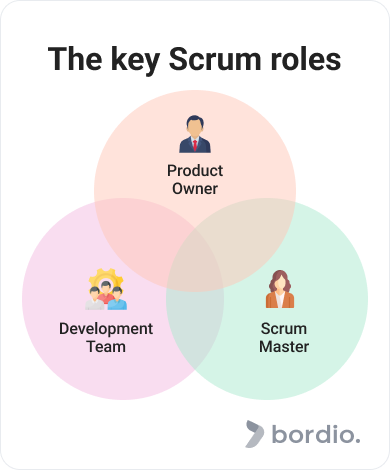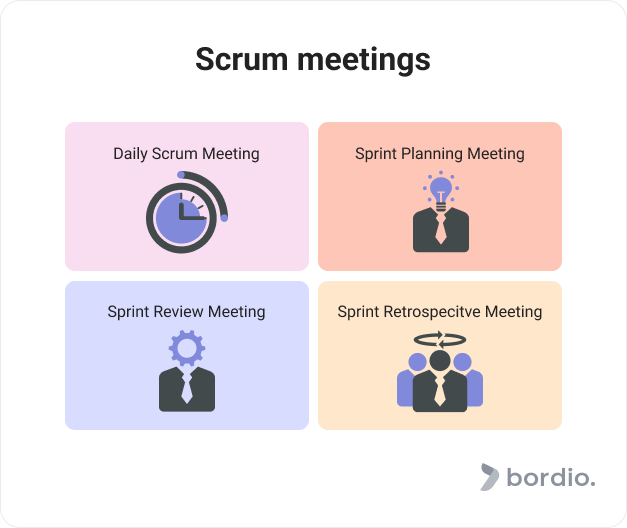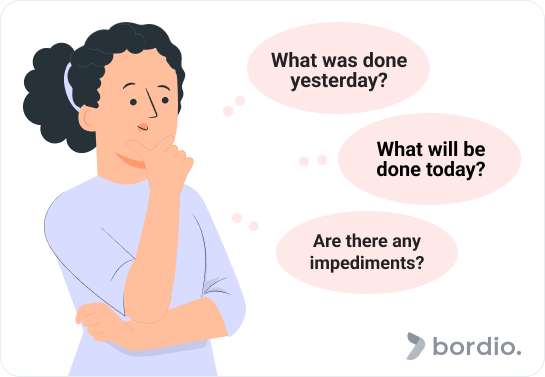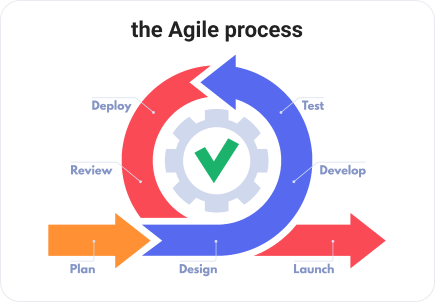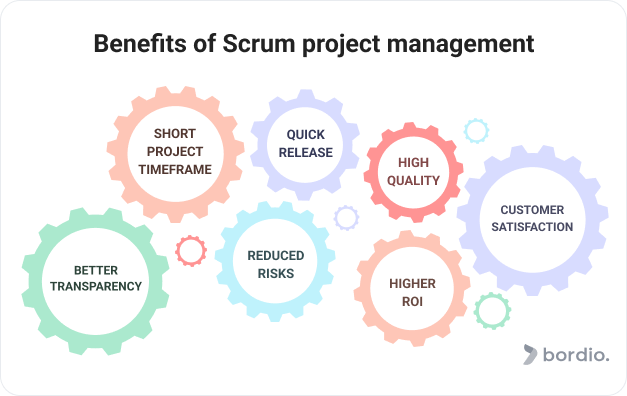Scrum project management is a part of Agile methodology that has become a standard in a large number of companies across the world. It is mostly used in software development, but some organizations practice it for non-technical projects.
Effectively, Scrum is a framework that represents one of the many approaches to Agile. Scrum is Agile, but Agile is not always Scrum. Scrum gives you a structure for delivery but leaves a lot of flexibility to the team in terms of practices and formats they use.
Scrum promotes learning by doing, in other words, through experiences. So, the companies that work under Scrum principles are encouraged to put all their knowledge into practice. You can control the team during planning by using time management tools.
What exactly does Scrum project management mean?
Scrum is an iterative framework that helps manage projects in sprints.
Sprints are short iteration cycles of 2-4 weeks during which the entire team (usually cross-functional) estimates and prioritizes product backlog and tasks and picks up a list of “user stories”, i.e. user needs or pains, to work on. That way, there is always the next thing to work on, and the development process is uninterrupted.
Thanks to its approach to project management, Scrum is highly flexible and allows project teams to respond to changes and challenges quickly, making sure the project benefits from any unexpected opportunity and mitigates risks asap.
Tip: You can read more about common project management challenges in our detailed guide.
Scrum also stresses the importance of independent work and personal responsibility. Ideally, the team would consist of self-organized employees who do not require micromanagement and have enough self-accountability to complete the tasks on time and with high quality.
Tip: Accountability can be trained and improved. Check our Bordio’s expert article on accountability in hybrid workplace for more detail.
The three key Scrum roles in project management are product owner, Scrum Master, development team. The additional roles are the business user and the project stakeholder.
The product owner is the one to communicate with stakeholders, business users, and other parties. Scrum Master is a servant to the team, and their role is to support and promote Scrum and Agile principles. The development team is essentially the rest of the project team.
The 5 meetings of a Scrum project
There are five meetings that are all part of the Scrum project management methodology. In the Scrum world, those meetings are called ceremonies, and they all play an important role in the development process.
The ceremonies are Sprint Planning, Daily Scrum or Daily stand-up, Sprint review, Sprint retrospective, and Backlog grooming.
Backlog grooming is often excluded from the Scrum ceremonies group and is just referred to as a meeting.
Scrum Masters participate in all meetings to monitor and assist the Scrum team with following the guidelines and using the ceremonies to their advantage.
Sprint planning
Sprint planning meeting is the start of the sprint. During this ceremony, the team goes through the product backlog (a complete list of features to be released) and picks a bunch which then becomes the sprint backlog.
During the sprint planning meeting, the team comes up with a sprint goal that outlines what value will be generated at the end of the time cycle. Agile software development supports sustainability, so the goal must be realistic without causing the team’s burnout.
The typical sprint duration is 2-4 weeks, and it’s during this planning session that the team decides how long the current sprint will take.
Daily stand-up meeting
Daily stand-up or daily Scrum is the next ceremony that is an incredibly important component of the Scrum framework. Stand-up meetings take about 15 minutes, require the entire team’s presence, and are often held actually standing up.
There are 3 main questions that every Scrum team member needs to answer during the meeting:
- What was done yesterday?
- What will be done today?
- Are there any impediments?
In the Scrum team, there is no project manager, and everyone shares the responsibility, so the purpose of the Daily Stand-up is not to report to someone but to share updates with the team. Should someone identify potential risks or any other impediments, the team reviews the issue together and uses collaborative decision-making to find a solution.
If there is no quick way to make a decision, the follow-up meeting is organized separately not to take up the time of the Daily Scrum.
Tip: The best way to make sure Daily Stand-up calls happen is to schedule them in everyone’s daily planner app as a recurring event for the same time every day. In as little as a week, it will become a habit to check the task tracker app and remember the task.
Sprint review meeting
As the sprint is moving towards its end, the sprint review meeting is held.
During the meeting, teams review the outcome that they’ve produced and make sure it is aligned with the requirements and delivers value to the business. Like everything else in the Scrum framework, sprint reviews do not need to be overly formal.
Product owner joins the meeting, sometimes accompanied by business users or other stakeholders, and they are presented with the end result, also known as the shippable product increment.
If the priorities of the business or some other conditions change, they can be communicated during the review, and the next Sprint goal or a product backlog as a whole can be re-considered.
Sprint review is a time when everyone comes together, so it is also used as an opportunity to catch up, improve communication, share feedback, and make sure everyone is on the same page.
Sprint retrospective meeting
Once the sprint is over, the sprint retrospective is scheduled.
Scrum is an Agile project management framework. It means that Scrum teams are always learning new skills and new ways and strive for improvement. The sprint retrospective ceremony is a way of systemizing such an improvement process without making it stressful or toxic for the team.
During the session, several key points are discussed:
- How can Scrum framework and Agile practices be applied in a better way than they currently are.
- How can teamwork be improved and optimized.
- Productivity, performance, and quality results: what’s the state now and what can be improved.
- Issues and risks that occurred during the sprint and how they can be avoided in the upcoming Sprint.
- What was good and worked well during the sprint and how it can be replicated in the future.
Tip: Sometimes sprints fail or produce mediocre results because teams are not using the right solutions. Bordio’s online calendar planner app ensures everyone is grinding through their to-dos, stay on top of deadlines, and manage workload to remain energized and productive. Use Bordio’s best time planner and improve your team’s time management.
Agile development is impossible without continuous improvement and reflection, so it’s absolutely critical for teams to host retrospective meetings before they launch the next sprint. If someone is hesitant or the general understanding of the meeting value is off, it is up to the Scrum Master to communicate and explain the role of the ceremony to all the team members.
Backlog grooming
Backlog grooming or backlog refinement is kind of in a unique position compared to other Scrum events.
It is held throughout the sprint, and there is no set time or date when it should happen. The teams decide when and how often they want to have those meetings. The only exception is that the very first meeting should be held at the beginning of the sprint. The best way is to schedule it right away in the team’s weekly planner for the first part of the week, so that there is no waste of time and delay with active work while you’re using the weekly schedule planner online.
As you have probably guessed from its title, the meeting is focused on the sprint backlog or even the general product backlog for the entire project. There, Scrum teams discuss:
- User stories review: break them down into smaller ones, add to or remove from sprint.
- Backlog priorities and if they should be updated.
- Dependencies between the tasks.
- Potential risks and ways of mitigating them.
The principles of Scrum
As a part of Agile philosophy, Scrum is ever-evolving, so countless interpretations can be found online and across the development world. Still, some of its principles stay unchanged, and we’d like to share them with you here:
Principle #1: customer satisfaction through continuous value delivery
The highest priority is to satisfy the customer through early and continuous delivery of valuable software.
This is the core of the Scrum process. Rather than implementing a gigantic project that takes a year to complete and only having a customer see some real results at the end of it, Scrum teams run short-term sprints that end with some kind of functioning solution that clients can play with and use in their work.
Such an approach to software development reduces the risks for both the project team and the stakeholders because the product is released (although partially) sooner and is tested by the end-user sooner. It means that the feedback is shared when there is still time and opportunity to make changes without causing huge drawbacks in terms of timeframes and budget.
Principle #2: change is good, and change is welcome
Requirements can change even late in development. Unlike in the traditional approach, Agile’s perspective on change is positive. It is believed to benefit the customer and strengthen their competitive advantage.
It happens regularly that the business needs and requirements change over time. Unfortunately, sometimes it happens in the middle of the project, leaving the development teams somewhat lost.
In Agile teams, change is not perceived as an issue but an opportunity to increase value and avoid having to re-do the solution in the future. The Scrum team might, like all of us, get frustrated about the unexpected change requests, but they are able to quickly adjust their priorities and processes to fit in the new requirement.
The goal of Agile project management methodology is not to finish the project with all boxes ticked but to provide the most relevant, best functioning solution to the business that matches their latest needs and really helps deal with the issues that were initially discussed during the project planning in task maker app.
Principle #3: deliver working software frequently
The software should be released often. Ideally, it should be showcased to the client somewhere between every couple of weeks to a couple of months. A preference is for the shorter timescale.
In traditional project management, such as Waterfall or PRINCE2, software development teams would work on the solution for months before the client could see even a hint of the features and interface. And when the software was finally demonstrated, it often turned out that either the features were no longer needed, the general logic was off, or there was something missing. And by that time, implementing changes would often be so expensive and complicated that the project was deemed a failure.
The Scrum process helps avoid those unpleasant scenarios with a quick turnout.
Principle #4: everyone works together as a team
Business people and the development team are often matched against each other. Yet they must work together daily throughout the project to reach the best results. To work better in a team we recommend using task organizer for teams.
A lot of Scrum success lies in promoting equality, fair treatment, collaboration, and healthy communication. There is no need to fight or compete with each other. Everyone works on the same goal and is motivated to have an excellent solution in the end.
Tip: If you feel that there is some hostility in the team, try managing it with a team building activity or quick ice breaker games before meetings. Sometimes little things like that can turn things around and boost team spirit, helping achieve all business goals for the sprint.
Principle #5: a motivated and self-sufficient team is a must
Scrum encourages building projects around motivated individuals, giving them the environment and support they need, and trusting them to get the job done.
Talented, motivated, and self-organizing teams are a must in Scrum project management. As there is no strict hierarchy and the methodology is very democratic, it is essential for every team member to have the right mindset.
Yes, Scrum goals and sprints are sustainable and allow people to work in a comfortable rhythm. However, there is still pressure to complete the work in a short timescale and with high-quality results. It is something that can only be executed by a disciplined and motivated Scrum team.
So, it’s recommended to scan and select the right people before the project starts. It’s best not to hire people who will not flourish in the Scrum environment. Not only will they feel burnt out and demotivated, but they will risk jeopardizing the entire project.
By the way, if your development team seems to struggle with deep focus, time management, or general productivity, we recommend checking out our blog post with the best time management and productivity books that will help you get back on track. In addition, we also recommend Bordio’s free time manager for better organization and focus.
Principle #6: face-to-face conversation is key
The most efficient and effective method of conveying information to and within a development team is a face-to-face conversation.
Whether it’s the product owner talking to the development team, stakeholders talking to the business users, or Scrum Master talking with everyone all at once – it is best to default to quick face-to-face chats rather than lengthy email communication or messengers.
When many people from different departments are involved in one project, and they all have their own motivation and interests, many things can go wrong due to poor communication.
Direct conversations help avoid most of the issues and misunderstandings which affect the project negatively.
Why should you use Scrum project management?
Scrum project management is easy to pick up. The methodology is pretty simple, so you won’t need to spend weeks in training before applying it in practice. It is pretty widespread too, so if you ever come across something you don’t understand, there are endless resources online to help you out. Or a certified Scrum Master will guide you through every step.
But it’s not just the ease of use that lures more and more projects into the world of Scrum. Here are some of the key benefits that you can expect after this Agile framework is introduced to your projects:
#1 Shorter project timeframe
Teams work through sprints on providing regular deliverables, taking less time to finish the product.
Because the development team narrows down the list of tasks and only works on the current sprint backlog, they are focused on creating specific things only. When there are 5-10 things to worry about instead of 50, things tend to be done a lot faster.
#2 Quicker release to the market
Sprints allow us to finish the planned functionality in short time frames. That means that the product is released to clients faster, and the next iterations are also frequent, making the solution more innovative and helping it stand out in the overcrowded market. It is convenient to use the services of b2b saas marketing agency for market analysis and marketing.
#3 Higher quality results
Scrum is transparent, flexible, and time-efficient. There is more collaboration and listening among team members than with traditional approaches. That leads to team members being on the same page and on the same side, building better products together. Also, testing phases starts only after the task is complete, so the final product gets to be fully tested start-to-finish, avoiding cases when testing showed no bugs but then some feature was changed, and the bug appeared but was left unnoticed.
#4 Better project visibility
In project management, many issues arise because of misunderstandings and confusion that are often a direct result of poor transparency.
Scrum is a perfect framework to mitigate those risks as every step of it is very transparent. The product owner, development team and Scrum Master understand what’s going on right now. They know the workload of the entire team and the overall project performance at any point in time. That avoids potential conflicts among the team and with stakeholders, as they can be instantly provided with a clear update whenever they request it.
#5 Higher customer satisfaction rate
Products are developed quicker. Iterations take a few weeks to a couple of months on average. High quality is prioritized. All those things increase customer satisfaction as they get well-functioning solutions that are regularly updated with relevant features.
#6 High team spirit
Like we mentioned already, Scrum methodology promotes independence and self-discipline while being transparent and working as a team. It is a very healthy environment for team members, especially if they are high achievers. People are generally happier without redundant micromanagement and politics. That inevitably leads to higher productivity and better morale.
#7 Reduced project risks
In traditional project management, all the tasks need to be finished first, and only then can the solution be demoed to the client.
With Scrum, nothing is set in stone, so teams are better prepared to meet changes and upcoming risks. What is more, Scrum focuses on building the solution and releasing it to the market as early as possible, instead of committing to a long-term, complicated project with a long list of tools and designs that need to be ready before the solution can see the light of day.
#8 Higher ROI
And last but not least, Scrum projects help get higher returns on investment (ROI).
Using Scrum is not a 100% guarantee that the project will be a success. However, it definitely allows teams to complete the projects faster. And the sooner the products are released, the faster the first sales start to come through. Additionally, not dragging the project for ages means less chance of wasting time and money on irrelevant or low-value things.
Implementing a Scrum project management system in your company
Just like anything else, Scrum is better accepted and implemented when your organization is welcoming it with open hands. The last thing you want to do is force Scrum methodology on your teams and managers.
So, to help you have a smooth Scrum integration and make the best of it, we prepared a list of tips to help you get started.
- Start from the top – talk to your managers, share your reasoning to implement the framework, showcase successful examples, explain the main points. Have patience: they’re likely to need time to do their own research and get a better understanding of the concept. Be prepared to have multiple meetings, Q&A sessions, and also work on your objection handling. If you face a lot of resistance, then maybe it makes sense to wait out and get back to this conversation in a few months. Your company and people working there have to be ready. Otherwise, you won’t get all the benefits and perks of the Scrum methodology.
- Consider hiring a Scrum Master or booking a few consultations with them before you start promoting Scrum. A Scrum Master is an expert who has helped countless teams and companies implement the framework and Agile principles. They know the best ways to launch Scrum in the company and can share invaluable advice.
Once Scrum is well accepted, and the next projects line up, it is time to start building the teams:
- Find the product owner for the upcoming project. They will be sharing and explaining the business vision, including what and why to the team and communicating with stakeholders (e.g. project sponsor, business leaders, tech leaders, users).
- Identify the rest of the team members. In the basic Scrum framework, the team traditionally consists of a Product Owner, Scrum Master, and Development team. The optimal size for the team is considered to be up to 9 people.
- As the project is launched, make sure the Scrum ceremonies are honoured and daily Scrum meeting is run by the development team. Daily meetings should be short and focus on updates from everyone: what they’ve been working on and what they will do today, potential or current issues, the general update on the project.
- Take it slow with sprint planning. As you’re only starting to work in accordance with Scrum principles, it’s best to start small and run 1-2 weeklong sprints and not have too grand sprint goals. That way, there will be less pressure as the team just starts to get used to the format.
Bonus tip: Make sure you have the right systems, such as an to-do list online to support your future Scrum projects. Technology can be a great helper in keeping things transparent, clear, and updated. No excuse not to use it!
Final thoughts on Scrum project management
Scrum is a flexible project management methodology that pays a lot of attention to team collaboration and delegation. It is about the continuous improvement throughout the product development cycle that allows teams to release the software in a matter of a few weeks. It supports adaptivity and embraces new conditions that should be taken into consideration and implemented in the project.
Scrum allows to deliver top products to the market fast and meet client and stakeholders’ expectations simultaneously, making it a great framework.

